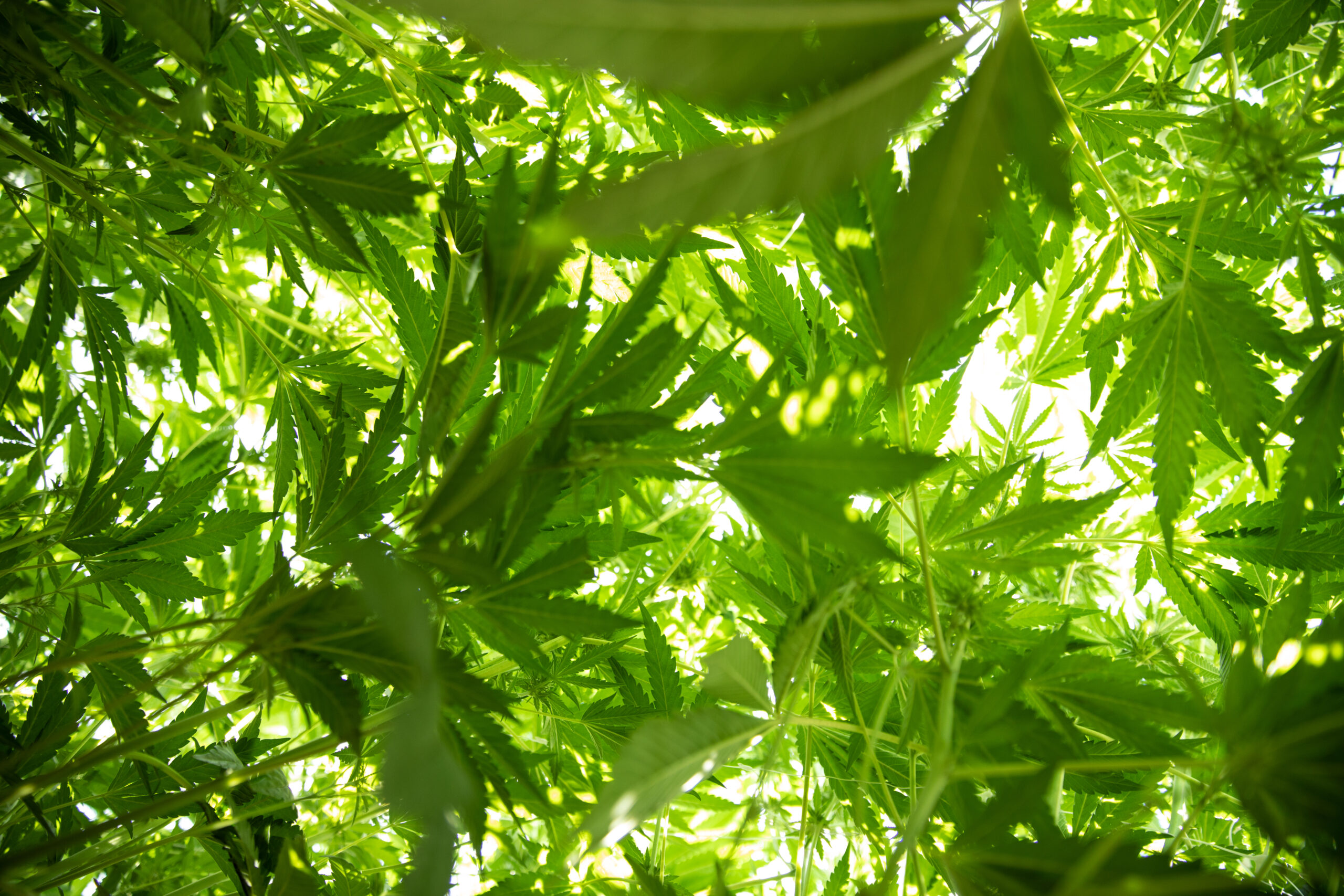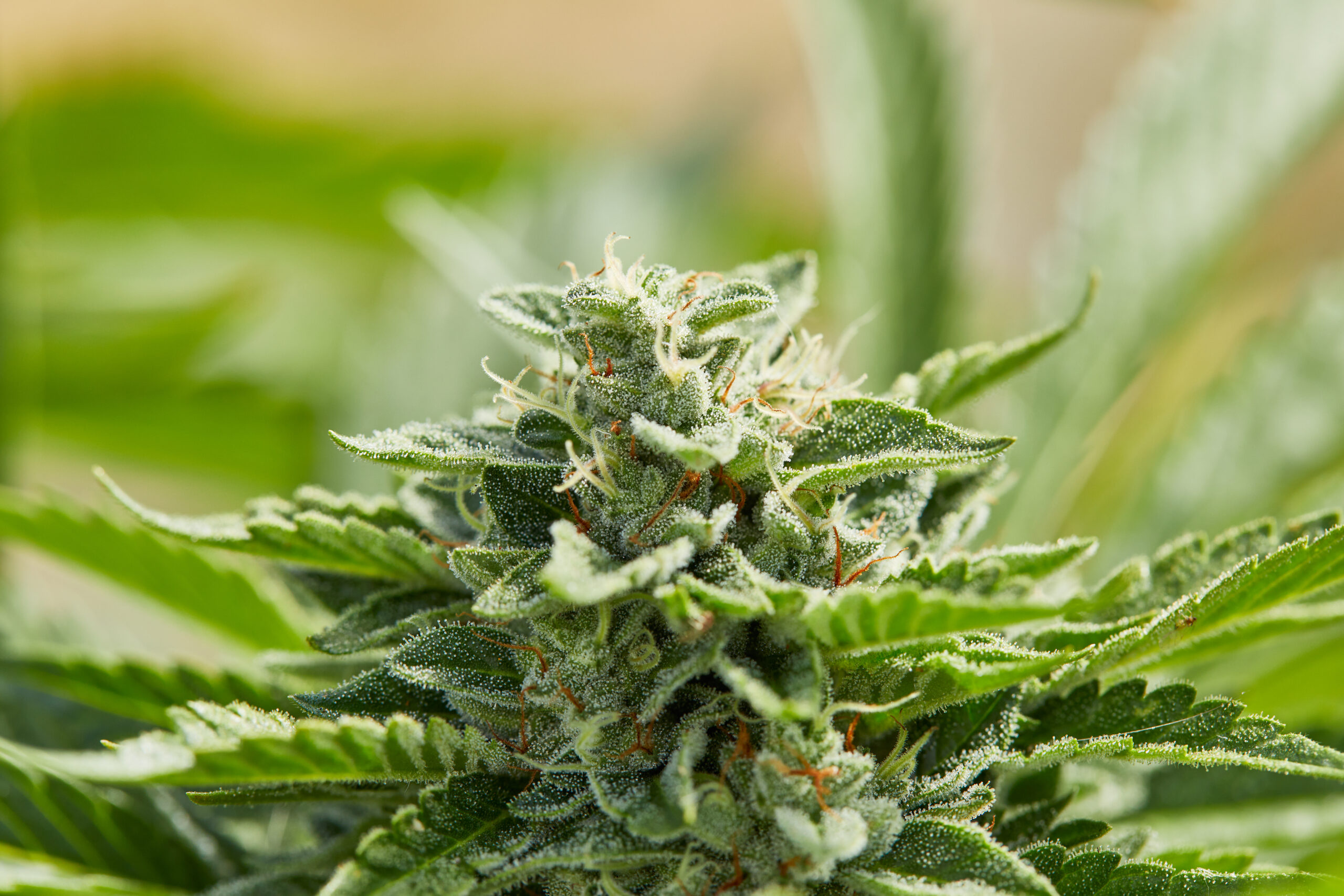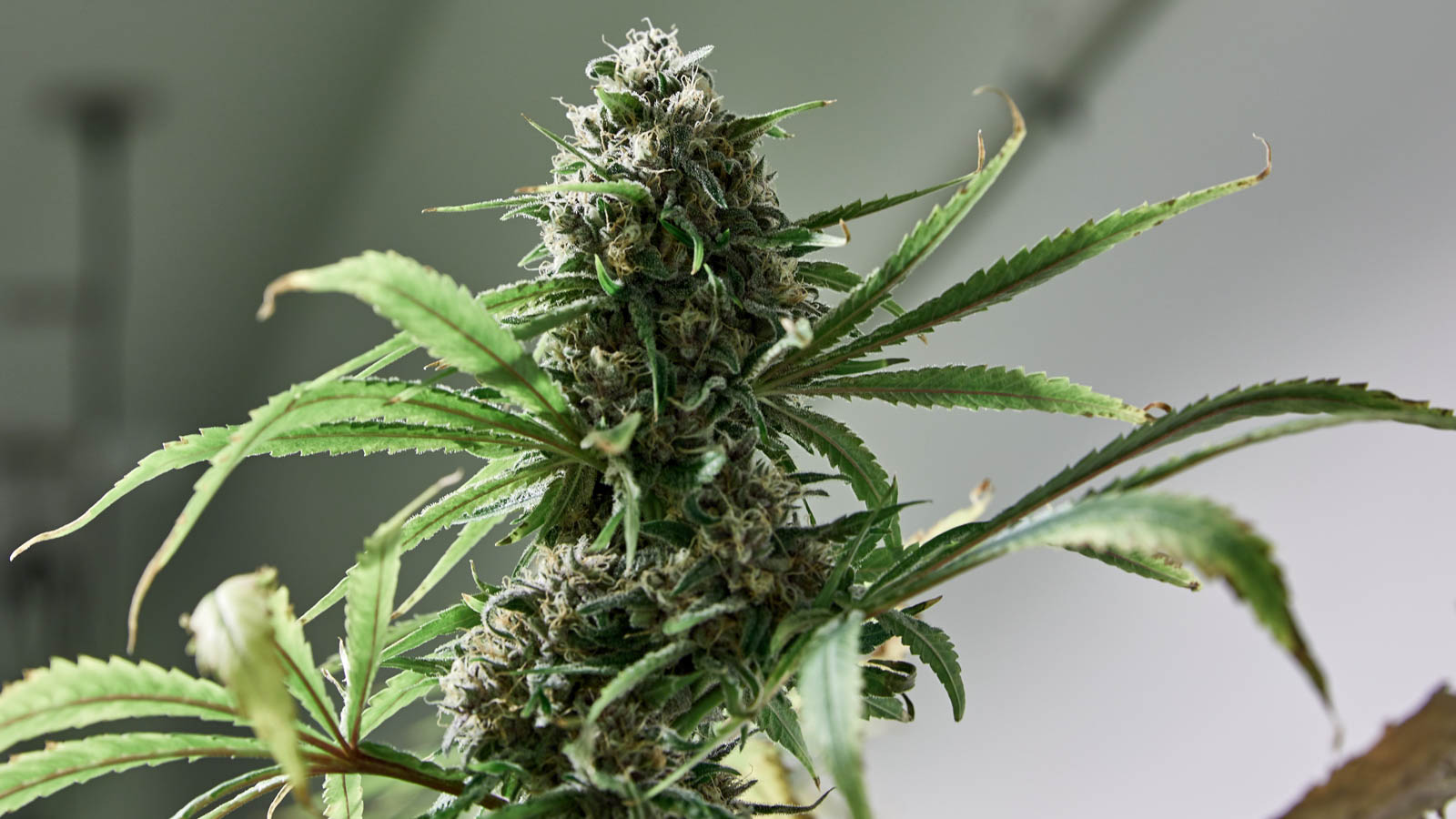Harvest time arrives, and your beautiful buds are enormous, frosty with trichomes, and practically begging to be smoked. But while harvesting seems like the final step in the cultivation process, there's one more stage that needs to occur in order to achieve maximum flavor, potency, and smoothness: drying. Learn how to dry your weed to produce the best-quality buds.
Why is drying weed important?
Many expert growers who produce high-potency cannabis point to the drying and curing process as their secret sauce.
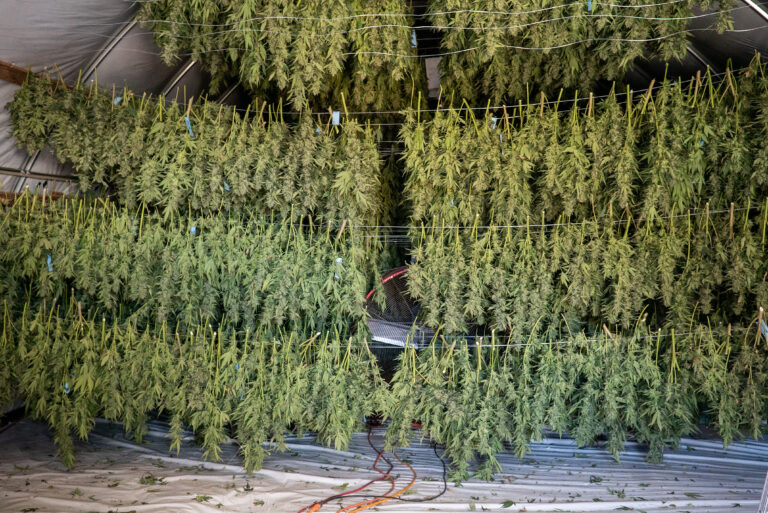 Photo by: Gina Coleman/Weedmaps
Photo by: Gina Coleman/WeedmapsImage lightbox

Even with great genetics and proper cultivation, drying and curing often make the difference between mediocre and award-winning buds. Here's why:
- Preservation: Properly drying and curing weed allows you to store it for extended periods — up to two years in proper environmental conditions. When freshly harvested, cannabis buds contain excess moisture that can create the perfect environment for mold to grow. Drying those buds eliminates excess moisture, which then provides a smoother smoke and reduces the chance of moldy weed while allowing stored bud to last a lot longer.
- Terpene retainment: Drying and curing retains the terpene composition in flower. Terpenes, or the compounds responsible for the bud's flavor and aroma, are fragile and degrade at temperatures as low as 70°F. Taking the time to dry and cure buds slowly, rather than in an oven or microwave, retains these terpenes and delivers the best result in terms of aroma and flavor.
- Higher potency: Proper drying and curing can boost the potency of your weed. THC slowly degrades into cannabinol (CBN), a cannabinoid with one-quarter the potency of THC, when it's exposed to light and air. Lower temperatures and less exposure to light and air prevent the degradation of THC, making for a more potent experience when it's finally time to smoke.
Although you can freeze-dry, oven-bake, dehydrate, dry-ice cure, or even water-cure your cannabis, the best product comes from patience and a watchful eye.
How long does it take to dry weed?
Drying weed takes anywhere from 5 to 14 days. However, many factors affect the cannabis drying process. Large, dense buds take longer to dry than small ones. How you choose to trim the plants can also lengthen the process, as larger stems retain water and take longer to dry out than shorter branches or individual nugs.
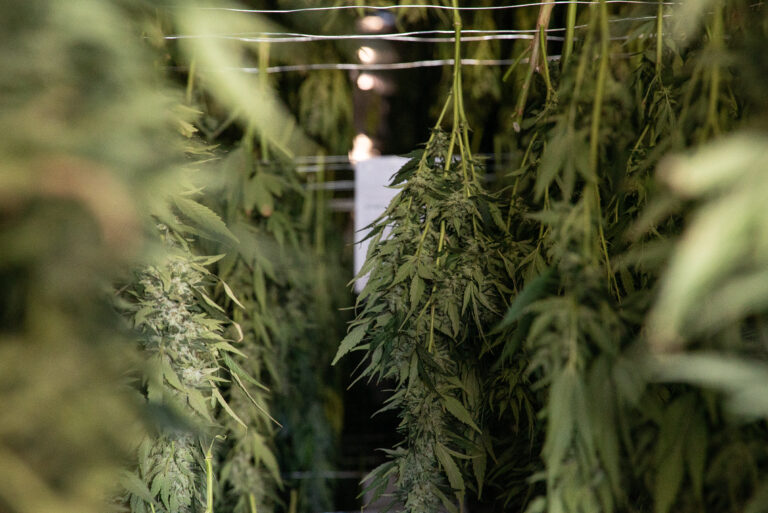 Photo by: Gina Coleman/Weedmaps
Photo by: Gina Coleman/WeedmapsImage lightbox

Proper temperature, humidity, and airflow in the drying environment also impact the process, so making sure they stay at optimal levels is crucial. To know if the buds are done drying and ready for curing, take a small branch and bend it. If the branch snaps, the buds are dry and ready to cure. If the branch bends or leaves stringy plant residue behind, continue the drying process. Buds separated from their stems will feel dry to the touch when they're ready.
What you'll need to dry weed
You may need additional materials depending on your specific situation and setup, but you can generally count on needing these items to dry weed at home:
- Trimming scissors or pruning shears: These will be used to trim excess leaves and stems from the branches before hanging them to dry.
- Drying rack or hangers: A drying rack made of wire mesh or strings can support cannabis buds without damaging them. You can also hang your plants from a clothesline or hangers.
- Twine or clothes pins: You'll need these if you're hanging your plants upside down.
- Hygrometer: A hygrometer is a device used to measure the humidity level in the drying room. This will help ensure that the humidity level stays at around 50% - 60%.
- Thermometer: A thermometer is a device used to measure the temperature in the drying room. This will help ensure that the temperature stays between 60 - 70°F.
- Dehumidifier or humidifier: Depending on the humidity level in the drying room, you may need to use a dehumidifier or humidifier to control the humidity level.
- Fan or ventilation system: A fan or ventilation system will promote air circulation in the drying room, which is important for drying the buds evenly.
- Gloves: Wearing clean, disposable nitrile gloves during the trimming process can help prevent contamination of the buds.
How to dry weed
Drying weed varies slightly depending on your preferred harvesting method. Use this basic method as a guide and adjust accordingly.
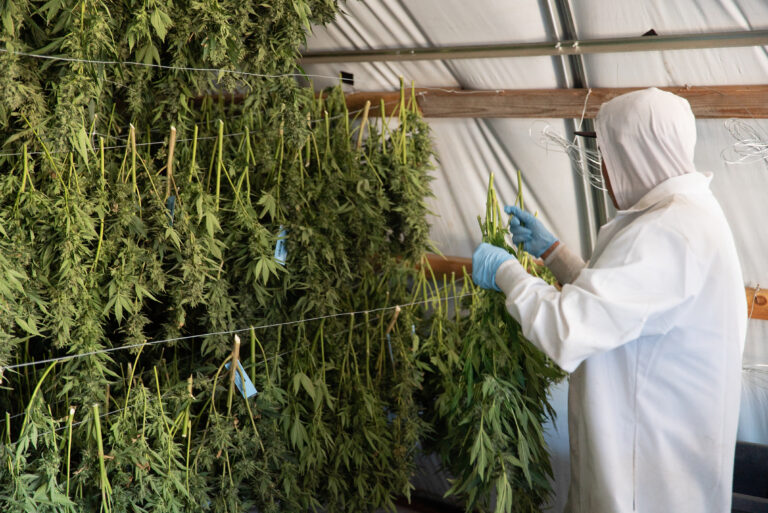 Photo by: Gina Coleman/Weedmaps
Photo by: Gina Coleman/WeedmapsImage lightbox

Approximate dry time: 14 days.
Step 1
Use disposable gloves. Put on your disposable gloves before starting the trimming process to avoid getting your hands sticky or contaminating the buds.
Step 2
Cut the branches. Begin the harvest process by cutting away 12- to 16-inch branches from the cannabis plants.
Step 3
Trim the branches. Trim away the large fan leaves and discard them or save them to make cannabis edibles or extracts.
Note: If you live in a dry environment, leaving some fan leaves intact may help your plants retain moisture and not dry too quickly. The ambient moisture present in a more humid climate, however, is likely to attract contaminants, so it's best to trim away everything but the buds from your branches.
Step 4
Hang your cuttings upside down. Hang them on a clothesline or drying rack in an environment that is not overly dry or humid. Leave the branches upside down to dry until the stems almost snap when bent.
Note: Some cultivators choose to snip the buds and leave them on a drying rack or cardboard box. If you go this route, leave enough space between the buds for air circulation.
Step 5
Check on your cuttings daily. Maintain temperatures between 60 - 70°F and a humidity level of 45% - 55%. Use a small fan to circulate the air and an A/C unit or dehumidifier to maintain optimal environmental conditions. If you're drying loose buds, regularly flip the buds to ensure they don't flatten or retain moisture.
Step 6
Be patient. Drying your cannabis can take anywhere from 5 - 14 days depending on the size and density of the buds, as well as the temperature and humidity level in the room. Be patient and try not to rush the process, as this can affect the quality of your final product.
Once your cannabis is dry, it's time to cure your weed.
How to set up a cannabis drying room
Here are some general guidelines to follow when setting up a drying room for your harvested cannabis.
 Photo by: Gina Coleman/Weedmaps
Photo by: Gina Coleman/WeedmapsImage lightbox

Step 1
Choose a suitable location. You'll need a clean, dry, and well-ventilated room that is out of direct sunlight. Your drying room should also be set up so that children and pets cannot access your cannabis plants.
Step 2
Clean the space. Before setting up the drying room, clean the space thoroughly to remove any dirt, debris, or pests that could contaminate the cannabis.
Step 3
Install a drying rack. Install a drying rack made of wire mesh or strings that can support your cannabis buds without damaging them. The rack should be big enough for you to leave enough space between the buds for air to circulate.
Step 4
Control the temperature and humidity. To provide a consistent temperature of around 70°F and a humidity level of around 50% - 60%, first use a thermometer and hygrometer to monitor the temperature and humidity level in the room. Then, use a dehumidifier or humidifier to control the humidity level, and a fan or ventilation system to regulate the temperature and air circulation.
FAQ
What's the ideal humidity for drying cannabis?
The ideal humidity for drying cannabis is around 45% - 60%. This humidity level helps slow down the drying process and prevents the buds from drying out too quickly, which can negatively affect the potency, flavor, and aroma of the final product. At the same time, if the humidity level is too high, it can lead to mold growth and spoilage of the buds.
To monitor the humidity level in your drying room, you can use a hygrometer, which is a device specifically designed to measure humidity. If the humidity level in your drying room is too high, you may need to use a dehumidifier to bring it down to the ideal range. If the humidity level is too low, you can increase it by using a humidifier or by placing a damp cloth or towel in the room.
What's the proper temperature for drying weed?
The proper temperature for drying weed is between 60 - 70°F. This temperature range helps to maintain the quality of the buds during the drying process, preserving the potency, flavor, and aroma of the final product.
If the temperature is too high, it can cause the buds to dry out too quickly, resulting in a harsher and less flavorful final product. If the temperature is too low, it can slow down the drying process too much, leading to the growth of mold and other contaminants. Use a thermometer to monitor the temperature in your drying room.
How should I store my dried weed?
After drying, you should use airtight containers — such as opaque glass jars — for the curing process. Learn more about how to cure weed.
What's the difference between drying and curing?
Drying involves removing moisture from buds to ensure they burn or vaporize properly. Curing involves storing buds anywhere from two weeks to six months in closed containers, allowing time to develop the terpene profile and potency of the flower.
How long does it take to dry weed after harvest?
The drying time for freshly harvested weed can vary depending on factors such as humidity, temperature, and the size and density of the buds. Generally, it can take anywhere from 5 - 14 days to dry weed properly.
How do I know when my weed is dry enough to cure?
You can tell that your weed is dry enough to cure when the buds feel dry to the touch, but not brittle or crunchy. The stems should snap rather than bend.
Should I dry my weed in the dark?
Yes, it's important to dry weed in a dark room to prevent the degradation of the cannabinoids and terpenes, which can be caused by exposure to light.
Can I dry weed in an oven or microwave?
It's not recommended to dry weed in an oven or microwave, as this can lead to uneven drying and degradation of the cannabinoids and terpenes.
Can I speed up the drying process?
While it might be possible to speed up the drying process by increasing the temperature or air circulation in the drying room, it's not recommended. Speeding up the process can negatively affect the quality of the final product. It's important to dry weed slowly and evenly to preserve its potency, flavor, and aroma.
Is it better to hang dry cannabis or lay buds flat?
Hang drying is generally considered better for drying weed than laying buds flat. Hanging whole branches upside down from a clothesline or drying rack allows for better air circulation around the buds, which helps to prevent the growth of mold and other contaminants. This method also helps to preserve the shape of the buds, as they maintain their natural form as they dry. Laying buds flat can cause the buds to become compressed, which can lead to uneven drying and potentially damage the buds.
Whichever method you choose, it's important to ensure that the buds are spaced out enough to allow for proper air circulation. Monitor the temperature and humidity throughout the drying process to ensure the best possible quality of the final product.
Written by Tony Daniels | Featured image by Gina Coleman

